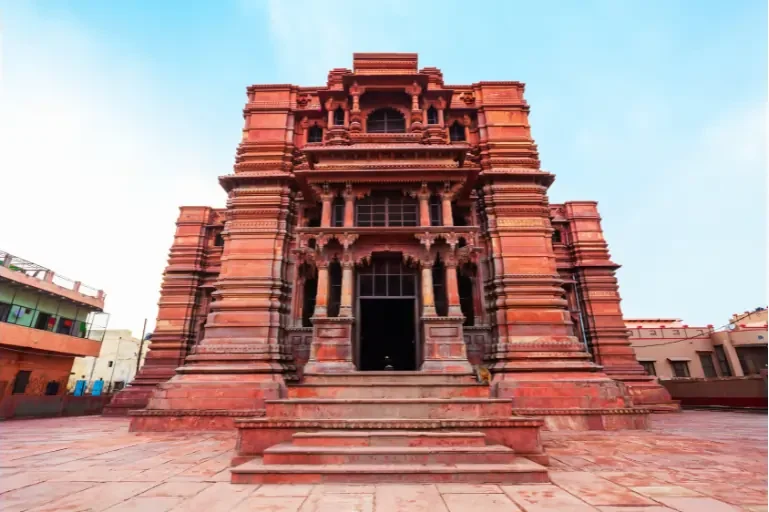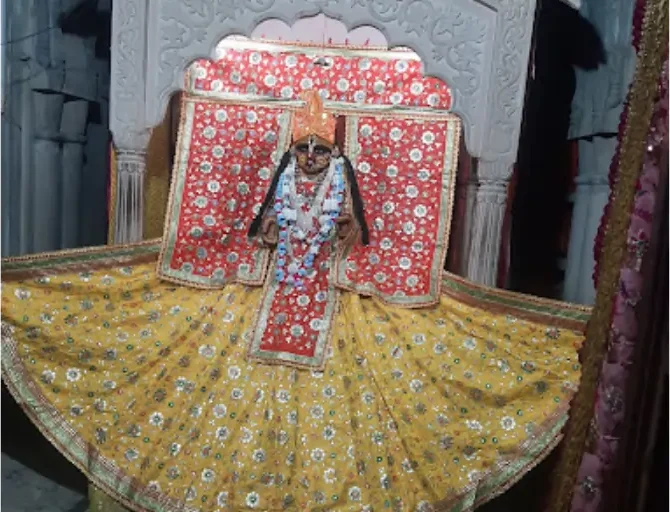Jaipur (the pink city of India) is usually known for its majestic forts, royal palaces and vibrant culture, but at its heart lies a story of timeless devotion- the journey of Govind Dev Ji— One of the most sacred temples of Lord Krishna.
Those who seek to explore something beyond the usual tourist spots in Jaipur, Govind Dev Ji Temple is one of the places to visit in Jaipur that offers to connect with the spiritual past of India.
The Complete History of Govind Dev Ji Temple
Govind Dev Ji temple attracts thousands of devotees especially on festivals like Janmashtmi and Holi. The residents of Jaipur consider this place very sacred, but very few people know about the detailed history of Govind Dev Ji Temple. A story that goes back thousands of years and flows through the spiritual winds of Mathura, Vrindavan and Rajasthan.
Filled with faith and preservation of sacred heritage, this journey is not only a symbol of devotion but also an important chapter in the cultural and religious history of India. Explore this amazing journey from the mythological origin of Govind Dev Ji’s idol to its establishment as a major deity in Jaipur.
Ancient Origins and the Creation of the Idol
The story of the origin of Govind Dev Ji traces back 5000 years ago, connected to the era of Mahabharat.
When the Yadu Civil War was going on. Amidst the chaos, the great grandson of the Lord Krishna, Vajranabh was the only one who survived and somehow he escaped from there. He went under the protection of Pandavas. Later Pandavs declared him the King of Mathura.
Vajranabh has always been a great devotee of Lord Krishna. Vajranabh used to ask his grandmother (the daughter-in-law of Lord Krishna) what Lord Krishna looked like as she had seen the Lord in actuality. When Vajranabh was around 13 years old, from his grandmother’s descriptions, he created an idol. Upon seeing the idol, his grandmother remarked that the feet closely resembled Lord Krishna’s. Thus, the idol was named Madanmohan ji, presently residing in Karauli, Rajasthan.
Vajranabh’s devotion didn’t stop at just one creation; his quest to capture Krishna’s likeness continued. He made a second idol, and this time his grandmother said the chest resembled the Lord, this idol became Gopinath ji, presently residing in Jaipur.
Further, he made another idol, and after seeing that, his grandmother got overwhelmed with emotions and said that this one looks like Lord Krishna!
That idol is Govind Dev Ji, presently residing in Jaipur. Vajranabh built several temples in Mathura and Vrindavan and installed these idols there. However, some legends says that he created 8 ‘Vigrahas’ in Braj –
- 4 Dev (Hardev, Baldev, Keshav Dev, Govind Dev)
- 2 Nath (Shrinath, Gopinath)
- 2 Gopal (Sakshi Gopal and Madan Gopal).
In ancient times, whenever any kingdom was under war, or attacked by rulers of different religions, the priests would bury the idols, and temple treasures to protect them from destruction and disrespect. As a result, during numerous invasions over the centuries, these idols were buried and eventually forgotten with time.
Rediscovery of Govind Dev Ji and the Revival of Vrindavan
By the 16th century, Vrindavan had almost lost its historical identity, and turned into a forest with no trace of the original location. In around 1514, a prominent saint, Shri Chaitanya Mahaprabhu, visited the site. He found lots of similarities in this place with the description mentioned in the old Indian scriptures, such as Bhagwat Puran about the place where Lord Krishna spent his childhood. During his stay, he discovered some places with references from the Bhagwat Puran. However, he could not stay there enough to bring the glory of the Vrindavan back to life, and so he returned to Puri, Orissa. Although he left the place, Mahaprabhu took memories of Vrindavan with him and studied more scriptures in detail. He eventually realized that Krishna temples and idols must still exist in the Braj region around Vrindavan and Mathura. This realization marked the beginning of Vrindavan’s revival.
To accomplish his vision, Chaitanya Mahaprabhu sent two of his disciples, (1) Roop Goswami to Vrindavan and (2) Sanatan Goswami to Mathura; both were brothers.
Shri Chaitanya Mahaparbhu specifically commanded Shri Roop Goswami to find and establish the lost original idols of Lord Krishna, and to re-discover and restore the holy places associated with Lord Krishna’s childhood and Leela (divine pastimes).
The Goswami bothers were later joined by:
3. Shri Jeeva Goswami (nephew of Roop and Sanatan)
4. Shri Raghunath Bhatt
5. Shri Raghunath Das
6. Shri Gopal Bhatt.
These six distinguished disciples of Chaitanya Mahaprabhu Ji later gained the name of “SHAD GOSWAMI”.
Highly dedicated to Krishna, Roop Goswami ji always prayed for the Lord’s Darshan (divine glimpse). He tirelessly searched for the lost idols but was unable to find them despite his relentless efforts.
It is believed that around 1525 A.D., Lord Krishna appeared to Rupa Goswami in a dream. In that dream, Krishna instructed him to find the idol, revealing a cow comes daily to Gomatila and pour milk there. Following divine guidance, Roop and his disciples went to the Gomatila and witnessed that a cow was actually pouring milk on the ground on its own. They carefully dug at the site and discovered the long-lost divine Vigrah (idol) of Govind Dev Ji.
Building of the Temple in Vrindavan
After finding the idol at Gomatila, Shri Roop Goswami ji served Govind Dev Ji in a simple thatched hut. There, Roop Goswami ji also installed an idol of Vrinda Devi, which he discovered at Brahma Kund (1518-1520) while returning to Vrindavan from the trip to Puri before the discovery of Govind Dev Ji’s idol.
According to Chaitanya Charitamrita, around 1535, a disciple of Shri Raghunath Bhatt, believed to be the Kchava chief of Amer, helped in building a more permanent temple structure. This was the start of the long association between the Kachava rulers and the Govind Dev Ji temple.
After some time in 1576, Raja Bhagwant Das of Amber, along with his son Prince Man Singh, started construction of a grand temple for Govind Dev Ji in Vrindavan at the same spot. The temple was completed in 1590 by which time Man Singh I had become the ruler of Amer and commander of the Mughal Empire during the reign of Akbar.

(Govind Dev Ji Temple, Vrindavan)
That seven-storey temple built with red sandstone was so grand that the light of a massive lamp burning every night on its peak could be seen as far as the Mughal capital of Agra.
Later, in 1633, Kachavas were put in direct charge of Govind Dev Ji temple. This was also the year when the idol of “Radha-Thakurani”, residing on the left side of Govind Dev Ji, was offered to the Lord. King Purushottam Dev of Orissa sent the idol to Vrindavan, and Radha Rani ji was married to Lord Govind Dev ji.
Some legends say that an idol of Sri Radhika, which was present in the Jagannath temple at a place called Chakrabati in Puri-Dham, was worshiped by all the people as Lakshmiji. Sri Radhika instructed Purushottam Dev in the dream: “I am not Lakshmi; I am Shri Krishna’s beloved Radha. I am waiting for the appearance of Shri Govind Dev in Vrindavan. When he appears please send me to him very carefully.”
The Mughal Threat and the Journey of Govind Dev Ji
After several years, It was the time when the political climate of India was changing with Aurangzeb on the Mughal throne. Unlike his predecessors, Aurangzeb’s approach towards Hindus was more aggressive. In 1669, Aurangzeb issued orders to demolish hindu schools and temples and restrain the hindu practices.
One night, Auranzeb’s attention was drawn to the light of that lamp. Upon discovering its significance, he issued orders to demolish the temple. But just some time before the attack, in between late 1669 and early 1670, fearing the destruction of the temple and the desecration of the deity, the priests and devotees decided to move Govind Dev Ji to a safer place. After the attack, only 3 floors of the original structure remained there and that still stands today as Govind Dev Ji Temple at Vrindavan.
The idol, along with its consort Radha Thakurani and the idol of Vrandadevi, was secretly moved from Vrindavan to Kamvan (Bharatpur), passing through Radhakund on the way. Kamvan is near the Braj region and was en route to Jaipur. The Yogmaya did not leave Vrindavan and still worshiped in the basement of the Govind Dev Ji temple at Vrindavan.
This began a long journey for Govind Dev Ji’s idol as the priests and devotees kept it relocating from one place to another over a span of 70 years for safekeeping until it finally reached its present home at Surya Mahal, Jaipur. Each time the idol was moved, a Pratibhu Vigrah (a replica of the deity) was installed at the original site for continued worship.
Some records indicate that Govind Dev Ji resided in Kamvan for some years along with the Thakurani and Vrinda Devi. Vrinda Devi still resides in the Vrinda Devi temple of Kamvan. Devotees often remark that the idol of Vrinda Devi feels so alive if you look at the goddess, you may feel the divine energy around.


(Vrinda Devi – Kamvan, Bharatpur)
Later, around 1675-1690, It is believed that Govind Dev Ji along with the consorts left Kamvan and moved to Govindpura (Ropada in Sanganer Region of Jaipur) which was offered to Govind Dev Ji as Bhog (grant/jagir). Govindpura provided further protection from potential threats. That place played a crucial role in ensuring the deity’s safety during the uncertain times of Mughal rule.
The temple of Govindpur situated on a hillside higher than the village is now completely dilapidated. It appears to have a very small temple. As the custom a Pratibh Vighra was established after the deity was moved. However, The temple eventually collapsed after India’s independence, it was a site of worship until that time.
The Final Journey to Kanak Vrindavan and Jaipur
Later in around 1714, during the region of Sawai Jai Singh II (the founder of Jaipur), the idol was moved from Govindpura to Kanak Vrindavan at Amer Valley. Nestled in the foothills near Jaipur, Kanak Vrindavan was chosen because of its proximity to the Kachwaha rulers’ stronghold, which provided essential protection for the idol.
On 18th November 1727, Jaipur was formed by Sawai Man Singh II. He was a devout follower of Lord Krishna and played an important role in bringing Govind Dev ji to Jaipur. Sawai Man Singh resided in Surya Mahal, where one night he dreamt that the site was destined for the Lord and that he should vacate it. Following the diving vision, he took guidance from the Goswami of that time and vacated the Surya Mahal for the Lord. He shifted the residence to a new palace Chandra Mahal (Royal residence of Jaipur) directly in front of Surya Mahal. The new palace was in such a position that when the king woke up in the morning, he could have the darshan of Lord Govind Dev Ji from there.
Lord Govind Dev Ji was then finally enshrined in the Surya Mahal. Jai Singh II ensured that the temple was constructed with grandeur and elegance, which is presently known as the “Thikana Mandir Shri Govind Dev Ji”.
“Thikana Mandir Shri Govind Dev Ji” – The Present-Day Temple
Today, the present Govind Dev Ji temple in Jaipur stands as one of the most sacred temples of Lord Krishna. Located within the City Palace complex, it signifies the close association of the Royal Family of Jaipur with the Govind Dev Ji.
Architect of Govind Dev ji Temple in Jaipur
Built with red sandstone, this temple is a beautiful sight for those who love to admire historical architecture. It is a unique blend of Rajasthani architectural styles in major with slight influences of Mughal and Western architectural styles.
The Govind Dev Ji temple is quite different from the traditional temples in India, as it notably does not have prominent Shikhars (domes). Even the idol is enshrined in a rectangular hall, surrounded by a beautifully adorned flat ceiling.
The main hall adjacent to the shrine is spacious and well-ventilated. No matter where the devotees stand in this hall, it provides them with a clear darshan, ensuring that they can feel connected with the divine. The ceiling of this is adorned with gold-plated exquisite floral and geometric patterns complemented with beautiful European chandeliers. The walls of this hall are decorated with scenes from Lord Krishna’s life, enriching the spiritual ambiance for visitors.
The main public entry is to the right of the temple. To the left of the temple is the Satsang Bhawan, which holds a Guinness World Record for the world’s widest RCC flat roof, with an unsupported span of 119 feet. The back side of the complex has lush green gardens that complement the temple with a calm and very peaceful environment ideal for devotion and meditation.
A Legacy of Devotion: The Enduring Journey of Govind Dev Ji
This amazing journey of Govind Dev Ji idol from the Mahabharata era to the present temple in Jaipur is more than history – it is a tale of faith, perseverance, and devotion of millions. This entire journey of the idol of Shri Govind Dev Ji has been pieced together from available documents (online and offline), traditional stories and historical references.
However, the traces of this journey are restricted in the terms of consistency and have some gaps in the timeline. If more records would get connected in the future with proper research then it would be more accurate to trace the relative position and journey of Govind Dev Ji in the history.
Nakul Hada is a travel blogger. He is a travel buff who especially loves road trips. He believes in exploring and self-learning which makes his article informative and practical. You can find him on Linkedin or on Instagram @nakulsinghhada.

What a fascinating overview of Govind Dev Ji’s history! I had no idea the idol creation process was so detailed and emotionally significant. How is the temple preserving its heritage while embracing modern tourism? Great read, thanks!